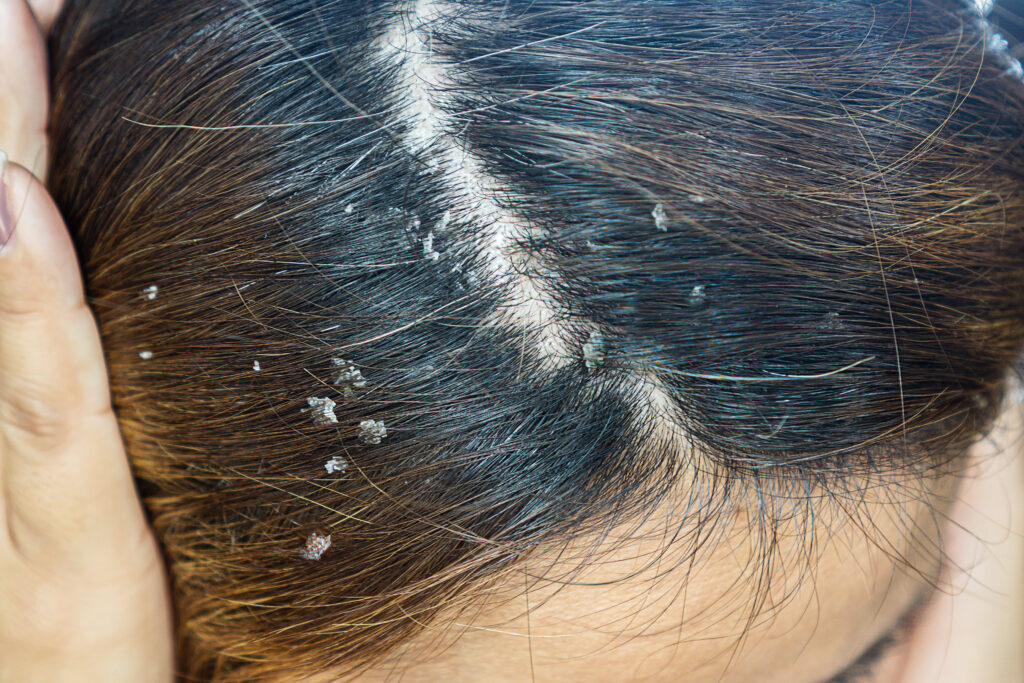Seborrheic Dermatitis
Do you have scaly patches on your scalp? Persistent dandruff that just won’t seem to go away? If yes, you could be experiencing seborrheic dermatitis.
A common skin condition that predominantly affects the scalp, seborrheic dermatitis can be easily treated and, in some cases, may even go away on its own.If you are not sure if you have seborrheic dermatitis or a different skin problem, the below guide is exactly what you need.
Read on to discover:
- What is seborrheic dermatitis?
- What are the main symptoms of seborrheic dermatitis?
- What causes seborrheic dermatitis?
- How to diagnose seborrheic dermatitis?
- How to treat seborrheic dermatitis?
- How to prevent seborrheic dermatitis
- How to live with seborrheic dermatitis
- Seborrheic dermatitis FAQs
What is seborrheic dermatitis?
Seborrheic dermatitis is a common skin condition that affects up to 5 in 100 people in the UK. Although it mainly affects the scalp, you can also get seborrheic dermatitis on areas of the face, such as the eyelids, ears, and eyebrows, and areas of the body.
Seborrheic dermatitis is a chronic or relapsing form of eczema or dermatitis, and there are both adult and infantile forms of this condition.
Adult seborrheic dermatitis tends to begin in late adolescence, and its greatest prevalence is in people aged 30-60. It is also more common in men than it is in women.
If you are born with oily skin, you are more likely to suffer from this skin condition.In children, infantile seborrheic dermatitis can affect babies under the age of 3 months but usually resolves itself by the age of 6 months up to 12 months.

What are the main symptoms of seborrheic dermatitis?
The most common symptoms of seborrheic dermatitis are:
- Skin flakes on the scalp, hair, eyebrows, or beard
- Red skin on the scalp, face, or chest area
- Itchy skin
- Patches of greasy skin that are covered with white or yellow scales or crusts
- Blepharitis. This is a seborrheic dermatitis eyelid symptom that manifests itself as scaly redness on the edges of the eyelids.
It is worth noting that mild seborrheic dermatitis may not have all of the above symptoms, but with severe seborrheic dermatitis, you are likely to experience more than one of these common signs. Your symptoms are likely to be much more noticeable.

What areas of the body does seborrheic dermatitis affect?
Seborrheic dermatitis can affect many parts of your face and body. Some of the most common seborrheic dermatitis affected areas are:
- Seborrheic dermatitis scalp
- Seborrheic dermatitis face
- Seborrheic dermatitis ear
- Seborrheic dermatitis nose
- Seborrheic dermatitis eyelid
- Seborrheic dermatitis eyebrows
- Seborrheic dermatitis forehead
- Seborrheic dermatitis neck
Some people also experience seborrheic dermatitis armpit and seborrheic dermatitis groin.
What causes seborrheic dermatitis?
The exact cause of seborrheic dermatitis is still unknown. However, medical professionals believe that the causes of seborrheic dermatitis are linked to:
Yeast
Malassezia, which is a type of yeast or fungus that naturally inhabits the oil glands of the skin, is one possible cause of seborrheic dermatitis. It is thought that people with this skin condition have an abnormal immune response to this yeast which results in an overgrowth.
Immunity
If you have a suppressed immune system, you are more likely to develop seborrheic dermatitis. For example, if you have HIV, have had an organ transplant, or have certain cancers, you may experience seborrheic dermatitis.
Climate
Your geographical location can affect your likelihood of getting seborrheic dermatitis. More specifically, if you live in a cold, dry area, you are more at risk. You are also more likely to develop this condition if you move to a new climate.
Stress
Stress is a common factor in people with seborrheic dermatitis, and it can also cause your symptoms to flare up. If you start to notice any signs of this condition, it can be a good idea to try and lower your stress levels.
Overall health
There are certain health conditions that make you more likely to develop seborrheic dermatitis, including heart disease, strokes, diabetes, Parkinson’s, depression, and obesity.
If you have an eating disorder or alcoholism, you are also more at risk.
Certain medications
If you are taking certain medications such as lithium, buspirone, Haldol, and chlorpromazine, you are more susceptible to seborrheic dermatitis. Other drugs that also increase your risk include interferon, psoralen, and the tuberculosis drug ethionamide.
Harsh chemicals
If you use harsh detergents, chemicals, or soaps on your scalp and other areas of skin, this may cause seborrheic dermatitis. If you already have this condition, these chemicals can worsen your symptoms.
How to diagnose seborrheic dermatitis?
Seborrheic dermatitis is easy to diagnose due to its noticeable symptoms on the scalp and skin.
If you have had seborrheic dermatitis before and you recognise the symptoms of this condition, you do not need to see your GP. Instead, look for an over-the-counter treatment such as Locobase, which can help to soothe your symptoms and any discomfort.
If you are unsure about whether you have seborrheic dermatitis or another skin condition, you may want to make an appointment with your GP or a dermatologist for an official diagnosis.
You do not need to give a blood or urine sample for a seborrheic dermatitis diagnosis, and you will not need to undergo any allergy tests.
In some cases, your GP or dermatologist may ask to take a skin biopsy to rule out more serious conditions. This is non-invasive and pain-free.

How to treat seborrheic dermatitis?
There are several treatment options for seborrheic dermatitis, depending on how severe your symptoms are. In most teenagers and adults, treatment is needed for this condition. However, in babies, seborrheic dermatitis usually clears up on its own.Some of the most effective treatments for seborrheic dermatitis are as follows:
For mild cases of seborrheic dermatitis
You can use an over-the-counter cream such as Locobase, which is applied directly to the affected areas. This treatment is designed for dry and very dry skin and is suitable for all areas of the face and body. You do not need a prescription for this seborrheic dermatitis treatment, and it is available at most pharmacies and online.
For long-term use, your GP may prescribe you an anti-fungal shampoo that contains ciclopirox or ketoconazole. These can be used daily for several weeks until your symptoms have disappeared.
You may also want to try topical corticosteroids or calcium inhibitors which can be applied to the face and body.
For moderate to severe cases of seborrheic dermatitis
If your symptoms are more severe and you have experienced little success with over-the-counter treatments, it can be a good idea to make an appointment with your GP or a dermatologist.
Firstly, they will be able to take a skin sample to determine whether you have seborrheic dermatitis or another skin or health condition. If you do have seborrheic dermatitis, then your doctor is likely to recommend a prolonged course of treatment, including anti-fungal shampoos and topical creams.
They may also suggest that you change your lifestyle to help manage your condition, such as giving up alcohol, managing your stress levels, and eliminating the use of harsh washing powders or bath products that contain chemicals.
Cradle cap
If your baby has seborrheic dermatitis cradle cap, you can try using olive oil or vegetable oil on their scalp. This can help to soften the area and make the skin less flaky.
If they have thick scales, you may want to leave the oil on overnight and then gently wash it out with baby shampoo in the morning.
How to prevent seborrheic dermatitis?
If the cause of your seborrheic dermatitis is genetic, then you cannot prevent this condition. In fact, most causes of seborrheic dermatitis cannot be prevented.
That being said, there are steps that you can take to reduce your risk of flare-ups and minimise your symptoms. These include:
- Do not use lotions and creams that contain alcohol
- Maintain a healthy weight
- Get plenty of sleep
- Manage your stress levels
- Practice safe sex to prevent contracting seborrheic dermatitis HIV
- Use specialist skincare products

How to live with seborrheic dermatitis?
If you have seborrheic dermatitis, you may experience issues such as low self-esteem, depression, and/or feelings of embarrassment.As a life-long condition that can be managed but not always cured, seborrheic dermatitis can cause a lot of emotional distress. If you are struggling with your mental health as a result of your condition, there are charitable organisations that can help you.
Seborrheic dermatitis FAQs
Is seborrheic dermatitis caused by poor hygiene?
No, seborrheic dermatitis is not caused by poor hygiene. The most common seborrheic dermatitis causes are suppressed immunity, an overgrowth of yeast, and certain medical conditions and medications.
What kills seborrheic dermatitis?
The most effective treatments for seborrheic dermatitis are over-the-counter creams such as Locobase, corticoid gels, and anti-fungal shampoos. It is also a good idea to try and manage your stress levels as stress can make your symptoms worse.
What causes seborrheic dermatitis to get worse?
Stress can make seborrheic dermatitis worse and can cause a flare-up to occur. Other factors such as being overweight and excessive drinking can also exacerbate your symptoms.
How do you fix seborrheic dermatitis?
In many people, seborrheic dermatitis is a long-term condition that can be managed rather than cured. Certain lifestyle changes such as losing weight, giving up alcohol, and getting sufficient sleep can all help to improve this condition. You may also want to try over-the-counter remedies such as Locobase, which is a topical cream or an anti-fungal shampoo for your scalp.
What foods trigger seborrheic dermatitis?
Although diet does not play a huge role in the development of seborrheic dermatitis, there are certain foods that can make your symptoms worse. These include cheese, tofu, bread, cake, biscuits, ketchup, and salty snacks such as crisps.
What is the difference between seborrheic dermatitis and psoriasis?
Although both seborrheic dermatitis and psoriasis are common conditions that affect the skin, they have slightly different symptoms. Psoriasis tends to display thicker scales on the scalp than seborrheic dermatitis, and it typically affects multiple parts of the body such as the elbows, knees, hands, or feet.Seborrheic dermatitis tends to manifest itself as red skin covered with greasy-looking white or yellow scales, whereas psoriasis scales tend to be flaky.
No products found